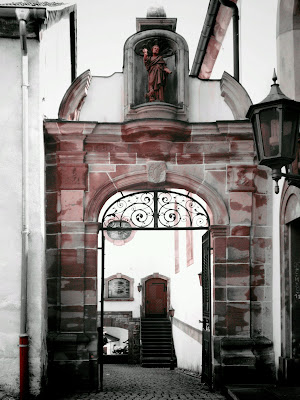2011-06-29
Ashes
Here lie the ashes of Heinrich, heir apparent to the County of Saarbrücken, who died in a riding accident in 1797, aged 29. In his will, he asked that his remains be brought to the family palace on Halberg Hill, Saarbrücken. In 1976, this wish was fulfilled.
2011-06-28
Schloss Halberg
This location, at the top of a large hill, is where the Count of Nassau-Saarbrücken built a Baroque palace in the 18th century. The palace was totally destroyed in the Great French War. At the end of the 19th century, Carl Ferdinand von Stumm-Halberg, a coal magnate, had this Neogothic building constructed. It is now the home of Saarländische Rundfunk (Saarland Broadcasting).
2011-06-22
Ossi nostalgia
A badge found on the Trabbi (2011-06-21), recalling life before the Wende.
Ossi; “East German”.
Wende: “turn”, “change”.
2011-06-18
Saarschleife
The typical view of Saarland's famous riverbend is overlooking it from the East (2010-07-23, 2009-08-24, Bonjour Luxembourg: "Locker bleiben" in Mettlach - Germany). This is from the other side of the river, in the bend itself.
2011-06-11
Wolfpark parking meter
I have no idea what the story behind this is. Why is there an ancient unused parking meter in the middle of a wolf reserve with the faded inscription “This is not animal feed”?
2011-06-09
Wolf man, Werner Freund
While humans may be able to train dogs, “you can’t domesticate a wolf,” Freund says. “I had to become a wolf” to be able to interact with them.
I think that quote answers the questions I posed in 2011-06-07 and 2011-06-08. These photos were taken in the Wolf Park in Merzig that Werner Freund founded (info in German, info in English).
2011-06-05
Staden fleurie
Has Saarbrücken become part of France again?
Addendum: I see my comment might be a bit cryptic. Saarbrücken has passed between French and German (or Prussian) hands several times. Between 1797 and 1815, it was actually part of France and, between 1945 and 1955, it was a French-run protectorate. Currently, it is very much part of Germany and pretty much monolingual. That makes this sign surprising. It is in French and says: “Flowery Staden (a part of Saarbrücken). National Council of Wild Public Gardens”. I think this French council does not exist, but it would appear to have awarded Staden a three flower rating.
Subscribe to:
Comments (Atom)





























